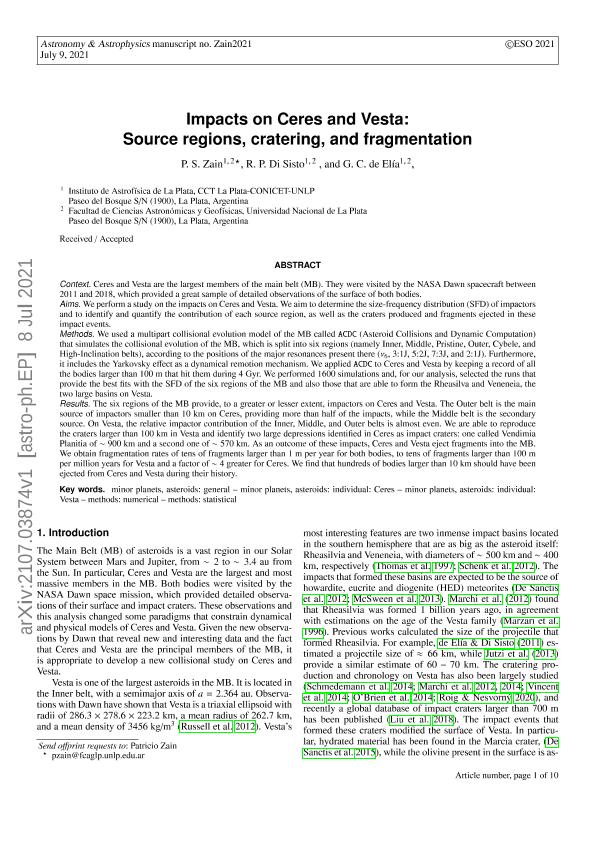Mostrar el registro sencillo del ítem
dc.contributor.author
Zain, Patricio Salvador

dc.contributor.author
Di Sisto, Romina Paula

dc.contributor.author
de Elía, Gonzalo C.
dc.date.available
2022-02-24T14:43:02Z
dc.date.issued
2021-08
dc.identifier.citation
Zain, Patricio Salvador; Di Sisto, Romina Paula; de Elía, Gonzalo C.; Impacts on Ceres and Vesta : source regions, cratering, and fragmentation; EDP Sciences; Astronomy and Astrophysics; 652; A122; 8-2021; 1-10
dc.identifier.issn
0004-6361
dc.identifier.uri
http://hdl.handle.net/11336/152662
dc.description.abstract
Context. Ceres and Vesta are the largest members of the main belt (MB). They were visited by the NASA Dawn spacecraft between 2011 and 2018, which provided a great sample of detailed observations of the surface of both bodies.Aims. We perform a study on the impacts on Ceres and Vesta. We aim to determine the size-frequency distribution (SFD) of impactors and to identify and quantify the contribution of each source region, as well as the craters produced and fragments ejected in these impact events.Methods. We used a multipart collisional evolution model of the MB called ACDC (Asteroid Collisions and Dynamic Computation) that simulates the collisional evolution of the MB, which is split into six regions (namely Inner, Middle, Pristine, Outer, Cybele, and High-Inclination belts), according to the positions of the major resonances present there (ν6, 3:1J, 5:2J, 7:3J, and 2:1J). Furthermore, it includes the Yarkovsky effect as a dynamical remotion mechanism. We applied ACDC to Ceres and Vesta by keeping a record of all the bodies larger than 100 m that hit them during 4 Gyr. We performed 1600 simulations and, for our analysis, selected the runs that provide the best fits with the SFD of the six regions of the MB and also those that are able to form the Rheasilva and Veneneia, the two large basins on Vesta.Results. The six regions of the MB provide, to a greater or lesser extent, impactors on Ceres and Vesta. The Outer belt is the main source of impactors smaller than 10 km on Ceres, providing more than half of the impacts, while the Middle belt is the secondary source. On Vesta, the relative impactor contribution of the Inner, Middle, and Outer belts is almost even. We are able to reproduce the craters larger than 100 km in Vesta and identify two large depressions identified in Ceres as impact craters: one called Vendimia Planitia of ~900 km and a second one of ~570 km. As an outcome of these impacts, Ceres and Vesta eject fragments into the MB. We obtain fragmentation rates of tens of fragments larger than 1 m per year for both bodies, to tens of fragments larger than 100 m per million years for Vesta and a factor of ~4 greater for Ceres. We find that hundreds of bodies larger than 10 km should have been ejected from Ceres and Vesta during their history.
dc.format
application/pdf
dc.language.iso
eng
dc.publisher
EDP Sciences

dc.rights
info:eu-repo/semantics/openAccess
dc.rights.uri
https://creativecommons.org/licenses/by-nc-sa/2.5/ar/
dc.subject
ASTEROIDS
dc.subject
CERES
dc.subject
VESTA
dc.subject
NUMERICAL
dc.subject.classification
Astronomía

dc.subject.classification
Ciencias Físicas

dc.subject.classification
CIENCIAS NATURALES Y EXACTAS

dc.title
Impacts on Ceres and Vesta : source regions, cratering, and fragmentation
dc.type
info:eu-repo/semantics/article
dc.type
info:ar-repo/semantics/artículo
dc.type
info:eu-repo/semantics/publishedVersion
dc.date.updated
2022-02-04T13:30:43Z
dc.journal.volume
652
dc.journal.number
A122
dc.journal.pagination
1-10
dc.journal.pais
Francia

dc.description.fil
Fil: Zain, Patricio Salvador. Universidad Nacional de La Plata. Facultad de Ciencias Astronómicas y Geofísicas; Argentina. Consejo Nacional de Investigaciones Científicas y Técnicas. Centro Científico Tecnológico Conicet - La Plata. Instituto de Astrofísica La Plata. Universidad Nacional de La Plata. Facultad de Ciencias Astronómicas y Geofísicas. Instituto de Astrofísica La Plata; Argentina
dc.description.fil
Fil: Di Sisto, Romina Paula. Consejo Nacional de Investigaciones Científicas y Técnicas. Centro Científico Tecnológico Conicet - La Plata. Instituto de Astrofísica La Plata. Universidad Nacional de La Plata. Facultad de Ciencias Astronómicas y Geofísicas. Instituto de Astrofísica La Plata; Argentina. Universidad Nacional de La Plata. Facultad de Ciencias Astronómicas y Geofísicas; Argentina
dc.description.fil
Fil: de Elía, Gonzalo C.. Universidad Nacional de La Plata. Facultad de Ciencias Astronómicas y Geofísicas; Argentina. Consejo Nacional de Investigaciones Científicas y Técnicas. Centro Científico Tecnológico Conicet - La Plata. Instituto de Astrofísica La Plata. Universidad Nacional de La Plata. Facultad de Ciencias Astronómicas y Geofísicas. Instituto de Astrofísica La Plata; Argentina
dc.journal.title
Astronomy and Astrophysics

dc.relation.alternativeid
info:eu-repo/semantics/altIdentifier/url/https://www.aanda.org/10.1051/0004-6361/202039373
dc.relation.alternativeid
info:eu-repo/semantics/altIdentifier/doi/http://dx.doi.org/10.1051/0004-6361/202039373
Archivos asociados
